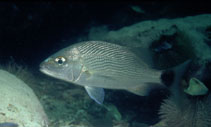| Family: |
Haemulidae (Grunts), subfamily: Haemulinae |
| Max. size: |
30 cm TL (male/unsexed); max.weight: 300.0 g |
| Environment: |
reef-associated; marine; depth range 0 - 50 m |
| Distribution: |
Western Atlantic: Panama to Santa Catarina, Brazil (Ref. 57756). Eastern Pacific: Mexico to Peru (Ref. 5530). |
| Diagnosis: |
Dorsal spines (total): 12-12; Dorsal soft rays (total): 16-16; Anal spines: 3-3; Anal soft rays: 9-9. Body oblong, compressed and not very deep (depth contained 2.5 to 2.9 times in standard length); mouth large and terminal, its posterior end located at the same level as the posterior edge of the pupil; first gill arch with 19 to 25 gill rakers; dorsal fin notched, with 11 to 12 spines and 15 to 17 soft rays (XI-XII, 15-17); second anal spine slightly longer and stronger than third; scale series above lateral line oblique; body dark brown or silver gray; each scale bearing a pearly gray spot, the spots appearing to form lines following the scale series; lower part of preopercle with a black spot; caudal peduncle with a large dark spot; fins grayish (Ref. 55763). Scales below lateral line oblique; anal fin more heavily scaled than other species; silvery gray or brown on back, silvery on sides, with dark lines following oblique scale rows; a large black spot at caudal base (Ref. 13442). |
| Biology: |
Found over sandy and rubble bottoms; occasionally on coral reefs and rocky areas (Ref. 3798). Rarely in clear oceanic insular areas (Ref. 5217). Often found in schools (Ref. 3798). Juveniles encountered near the shore, over sandy bottoms near seagrass beds (Ref. 9626). Feeds on benthic invertebrates (Ref. 3798). Marketed fresh (Ref. 3798). |
| IUCN Red List Status: |
Least Concern (LC); Date assessed: 10 October 2015 Ref. (130435)
|
| Threat to humans: |
harmless |
Source and more info: www.fishbase.org. For personal, classroom, and other internal use only. Not for publication.

